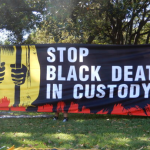Australian Prison Life: Part 1, What’s Life Really Like Inside Prison?

This is the first of a three-part series about what happens inside Australian prisons.
Each episode will also include a story of a particular inmate who makes life bearable for others.
There was an American television show about policing which ran from the late 1950s called the naked city (referring to New York) which ended each episode with the statement that there are 8 million stories in the naked city, this has been one of them.
Perhaps the same applies to life in Australian prisons – each inmate has a different experience and a different view about the time spent behind bars.
That said, here’s one of those views.
What is prison?
Prison is a secure environment where people charged with or convicted of committing a crime are confined and restricted from leading a normal life.
It is a place where your body is subjected to lawful assault under judicial sanction, without recourse to an appeal and by this I refer to the body searches of the most intimate and debasing aspect on a daily basis sometimes.
In Goulburn’s supermax prison, your body is also scanned.
It is an environment where strip-searches are frequent and cells virtually invaded by yelling security personnel dressed as commandos, with dogs and their dirty paws and dripping saliva trawling over your bed.
Foodstuff, such as coffee, sugar, rice, salt, pepper and packets of cereal are emptied out and then put back, in case contraband has been hidden within. Hygiene is never on the minds of the invading party.
Tubs of margarine and jams are poked in and even emptied for the same reason, with the same potential for food poisoning as a consequence of the lack of hygiene aspect.
Several times a day the call of muster up is heard, which is when you stand by your cell door to ensure you haven’t escaped.
All through the night, the guards check you are still in your cell, announcing their arrival by jangling keys and at times, noisily rattling of the door to ensure it is still locked and that you haven’t escaped from lawful custody.
It is not infrequent that if you’re covered with a blanket on cold nights, that a torch is shone on you through the trap door, until it is clear that you are indeed in bed.
The imprisonment of many criminals in corrections facilities is unwarranted:
Prison is a necessary evil in certain cases for the safety of others, but is used far too often, for the reason being is that it is not simply the perpetrator of the crime who suffers.
It is much more important than that.
For every guilty prisoner, there are many innocent people sentenced also, despite having committed no crime.
These are the parents, grandparents, spouses, sons, daughters and siblings, who grieve and suffer in many ways, often much more than the family member sent to prison for a criminal offence, and this frequently takes the form of mental illnesses.
Contact visits with family are generally once per week.
This is inadequate time to address the many aspects relating to the family, children, finances, health including mental health and the many other matters needing to be addressed within a family.
The orphans of justice
The consequences of imprisonment on a child when a parent has been incarcerated, and the ways to potentially reduce the impact, have been extensively discussed in white papers since 1946 and still, we haven’t got it right.
The issues may also include depression, homelessness, loss of self-esteem, post traumatic stress disorder, self-harm, destructive behavioural problems and in many instances, suicide ideation, including the actual act of suicide; potentially, by more than one member of the family at the same time.
All because the father or mother is imprisoned.
These ailments are also experienced by incarcerated men and women, who in many instances suffer from guilt in having caused the demise of their family. For that is what occurs and in reality, no one really cares, apart from the charities who assist with food and shelter and human rights organisations where possible.
Governments certainly don’t care, for there are no votes in prisons, unless it is to be tough on crime, to the point whereby it is draconian and perpetuates the hopelessness and helplessness which leads to destructive and even dangerous conduct – and the cycle continues.
Prison structure
Prison structures include what are termed as units or in the early days, divisions.
In NSW, Long Bay Correctional Centre has:
- Metropolitan special programs centre (A maximum and minimum security institution),
- Long Bay hospital (A maximum security institution for medical and psychiatric cases), and
- Special purpose centre (A maximum security institution for inmates requiring special protection).
In Victoria, Barwon maximum security prison has:
- Mainstream (is where the majority of inmates with no apparent issues reside),
- Management units (house those who have committed prison offences or who have enemies within the mainstream compound), and
- Protection units (hold those who have been witnesses against others in court matters, sex offenders and paedophiles, generally speaking).
Some prisons have a Hospital wing and perhaps, a psychiatric unit.
Supermax prisons
Appearing in an Australian prison in 1975, was the supermax style prison unit called Katingal, which was constructed within the Long Bay correctional centre in Sydney and consisted of 40 prison cells and nicknamed the electronic zoo; a result of it having electronically operated doors.
It also had surveillance cameras and no windows and was closed down approximately 2 years later after protests from human rights organisations.
A quarter of a century later, NSW Goulburn correctional centre opened a supermax facility, which although an improvement on Katingal, still worked on a similar objective of sensory deprivation. It included those inmates considered beyond rehabilitation.
Alcatraz, the notorious United States penitentiary constructed in 1934 on Alcatraz island, although not called a supermax prison at the time, was considered a prototype for what would become supermax gaols.
Many supermax prisons worked on the principle of inmates being locked in their cells for 23 hours per day.
However, unless you were charged with or convicted of a terrorism offence, or had caused carnage in other prisons, it would be unlikely you would be placed in a supermax environment, which incidentally has anti-helicopter security in case someone decided to leave earlier than the authorities had planned; which did occur in New South Wales when inmate John Killick escaped by this method from Sydney’s Silverwater Metropolitan Remand and Reception Centre in March 1999.
In Victoria, Barwon maximum security prison also has a supermax format called Melaleuca, named after over 200 species of melaleucas, which are endemic to Australia.
Several of this species develop into what is known as the tea tree or sometimes paperbark tree.
In Australia, mainly northern Australia, there are in excess of 6 million hectares of melaleuca native forest.
Acacia, another management unit, is also regarded as a supermax environment within Barwon prison, where the self-proclaimed premier of Victoria, Carl Williams was murdered in April 2010, which Sir Ken Jones an eminent law enforcement specialist and former deputy commissioner of Victoria police suggests involved bureaucratic corruption.
The routine of an inmate’s day
Generally, the day starts with those who want to keep fit, going for a jog, or loosening up with some exercises, breakfast, then work in the industries or education, depending on where you are located within the prison.
You may have to attend programs, again, depending on the plan set for you and what your social interests are, such as music or arts and crafts.
Profiting from imprisonment
It has been reported that in 2020/21, New South Wales, which has close to 13,000 prisoners compared to Victoria’s 7,000, reported profits from prisons of over $50 million on revenues of $138 million.
The commercial arm of Corrective Services Industries (CSI) – which can be seen as part of the ever-expanding prison industrial complex – is involved in excess of 170 business ventures in metropolitan and regional corrective services centres throughout NSW.
This includes building affordable housing for Aboriginal communities across rural NSW, Aboriginal art, engineering, building projects , laundry services, agriculture and technology.
One of the jobs for women inmates is taking care of their children in residential units at three NSW facilities, another is untangling Qantas head sets and repackaging them, with other jobs being maintenance and food services positions.
Women prisons in 5 other Australian states and 2 Territories also have mum/children residential accommodation, with South Australia the exception.
Victoria, generally, some inmates start their day with a jog, or a gym workout before breakfast and heading off to prison industries where they are employed in a variety of work, some of it menial though there are some skilled employment in welding, gardening, driving lawn mowers and painting.
Most establishments have a maintenance gang, which under a qualified supervisor address a variety of chores involving ensuring that minor repairs are carried out.
The prison farms are where dairy farming, horticulture and animal husbandry are on offer, permitting qualification for future employment on the outside.
Prison farms also contribute with manpower assistance when there has been flooding or bushfires in the country areas.
In some facilities, inmates can learn to drive a forklift and become qualified as such.
Others attend school, with some working in the kitchen, where they are able to attend hospitality courses via technical and further education (TAFE) courses.
All prisoners under the age of 65 years are expected to work whilst undergoing a sentence, for what is regarded as slave labour by many human rights organisations; unless the inmate is on remand, ill, attending education, or undergoing rehabilitation course. Of course remandees are still encouraged to seek employment.
In Victoria, if a prisoner refuses to work, he or she can be locked in their cell for the duration of the work hours each day.
Inmates are expected to work, with skilled trade-trained inmates called essential workers, peer educators and hairdresser being the highest paid prison employees. Apart from staff of course.
An independent inmate
Now, to the routine of one particular prisoner, known as the jailhouse lawyer, a name he despised, as he was simply a person who for 13 years had assisted inmates in all forms of administrative tasks.
Ranging from writing letters for inmates to their families, for there are many inmates who have difficulty in reading and writing, including filling out forms for employment in prison industries, to requesting a reduction of their security status.
This inmate was older than most and also assisted in proof reading assignments for several inmates who were doing tertiary education online.
Many were also inmates who desired to appeal their conviction or the term of their sentence, but neither did they or their families have enough funding to hire private lawyers.
The older inmate had worked in the UK Civil Service as a young man, in the legal division as a clerical officer in the post office savings bank’s death claims branch in Glasgow, Scotland and London, England.
He could read and understood legalese and undertook to research what was required, so the inmates could file in the Courts as self-represented litigants.
Well in excess of 95% of this work was done pro-bono, with those few who were rather financial paying a fee.
The aspect of legal aid had been explored first and foremost and when refused on the basis it was determined that it didn’t have the merit to warrant it, some accepted that was the end of the road in their quest to appeal.
Others though still wanted to make application and despite being advised that the chance of success was nigh on impossible wished to proceed.
This was acceded to by the inmate assisting, based on the fact that a number of months would pass, with the hope of the appeal being successful, meaning that, no matter the outcome, another portion of their sentence would have passed. It’s a jail thing!
The old guy had saw both his appeal to the Supreme Court and High court dismissed, but also lived in hope for the time it took to dismiss the appeals, that he was going to succeed in his quest.
The Jailhouse Lawyer (a tag he detested for he had many friends who were bona fide solicitors and barristers) assisted several hundred inmates from all Victorian corrections facilities in a numbers of areas as outlined above, including a small percentage in preparing applications for appeals in the Courts.
His legal friends were happy to assist him pro-bono in checking the preparation and explaining legal matters he had difficulty in understanding.
Megan Ellerton of the Registry office of the Supreme Court of Victoria and Rosemary Mussolino of the Melbourne division of the High Court of Australia would advise him in areas of compliance with the rules and procedures of the Court.
When the older inmate left prison, he had several outstanding matters to conclude and after informing their Honours of his background, was permitted to attend the Supreme Court as a McKenzie Friend, to articulate the argument of the inmate whom he was assisting.
He was permitted to sit at the Bar Table by Her Honour, Justice Hollingworth, with the approval of opposing Counsel, whom he had also informed of his history and whom assisted him in certain aspects of Court protocol.
Some were successful with legal aid being granted and happy that they had real qualified lawyers representing them, offering of course a significant improvement in terms of the opportunity for a successful outcome.
Barwon office
The general manager of Barwon prison, at the time also acting director of prisons was a friend of the old man long before he went to the dark side, with the GM’s son going to school with his grandson and his daughter, going to school with the McKenzie friend’s granddaughter.
With the work that he saw his now criminal friend doing, he arranged an extra desk in the common room and the use of a storeroom in the long-term unit, Eucalypt, where he was approved to use a computer for research; as it was clear that the work being done was beneficial in the maintaining of the good order of the prison.
Back to the routine:
Like many inmates, the old man was let out of his room at 8.00 am, when he would go for a jog, then do a gym workout before showering and being at his desk in the common room where he would get to work assisting others.
It should be noted that the old inmate was happy to be so busy as he maintained it made him relevant again, in such a depressing environment. He also spent a couple of hours each day, employed as a gardener in prison industries.
The evenings were when he would continue work in his cell, or room as he called it.
The old man is in fact your author, David McCulloch, or just David.
Coming up…
Hope you enjoyed my first instalment about Australian prison life.
Stay tuned for the next episode in this series, which outlines some of the more effective alternatives to prison and how, if prison is inevitable, the potential for family hardship, mental illness and breakups can be reduced.






